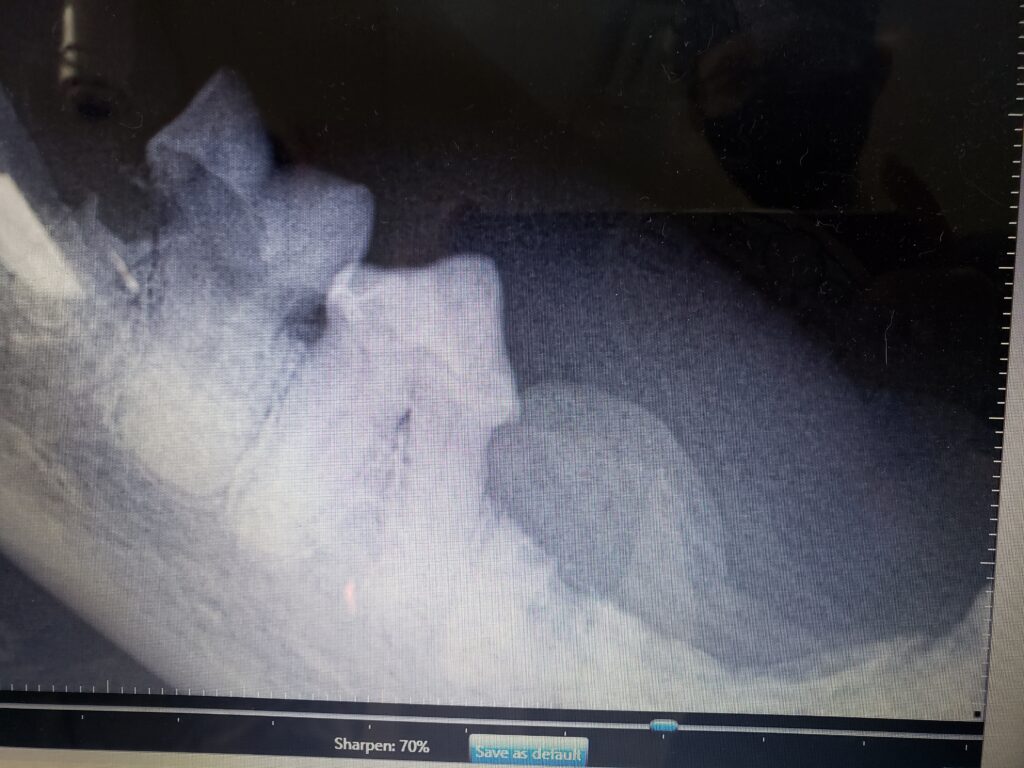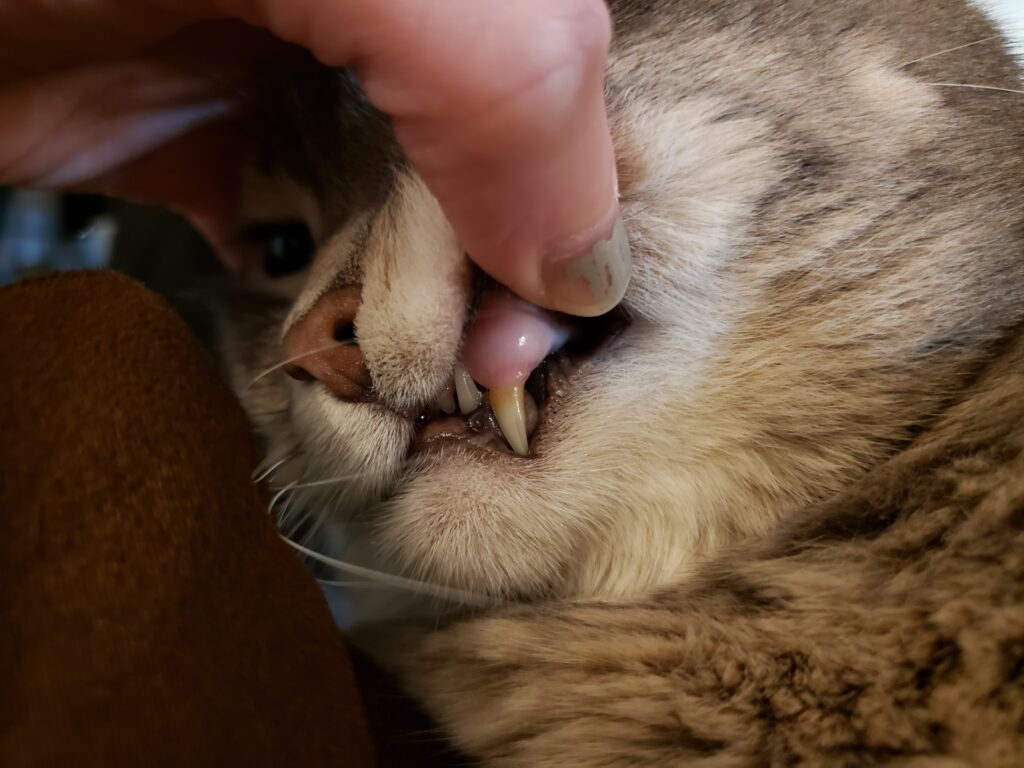Does your dog or cat have terrible breath? Is he or she chewing funny? Dropping food? Even worse, missing teeth that were there before? Dental disease is extremely common in dogs, cats, and even rabbits! This is incredibly painful for your furry friend, and can have some hidden effects as well.
Whole Body Effects of Dental Disease
In dogs and cats, dental disease leads to a huge amount of bacteria in the mouth and under the gums. This is what causes your dog’s tooth to get lose! The bacteria eat away at the tooth root and bone surrounding it to weaken the attachment. Did you know with dental disease, every time your pet bites down, it causes the bacteria to enter the blood stream? The bacteria can then lead to minor kidney damage, which adds up over time, and sit itself on heart valves, making heart disease a much bigger issue than it had to be before.
On top of the bacteria issue, it is painful! Chronic pain leads to chronic inflammation. This further weakens the attachments of teeth, and allows bacteria to get even deeper. This leads to a tooth root abscess, where pus and bacteria build up under bone. Eventually, it eats away enough bone to ‘rupture’ outside of the face and start leaking. As you can imagine, this is incredibly painful.
How serious is dental disease? (Sad paragraph ahead)
Dental disease is a quality of life issue, and severe dental disease can be a reason to euthanize your pet if you do not want to have a dental performed with a veterinarian, even if she is otherwise healthy. It is that painful. Most pets continue to eat despite dental pain, because their options are to eat through the pain or starve to death. Their appetites may decrease, and they may change their preferences in types of food (soft vs. hard). Often we see them start to eat only ‘good food’, such as people food, or only certain flavors of food, since they do need something delicious to entice them to eat. The most common symptom of dental disease at home, though, is simply decreased energy and willingness to play. This is always a gradual decline, and often owners report pets are playful again after their dentals!
Dog can cat dental disease presents itself differently and so it can be hard to detect at home. If you are concerned at all about your pet’s teeth, make an appointment with your veterinarian today!
Doggy Breath
Dogs are most prone to dental calculus (tartar) and gingivitis. You may notice the calculus on your dog’s teeth when you lift up his lip. This can be grayish or brown in color, and is most common on the back big teeth. Calculus itself is not harmful, but often is indicative of gingivitis (inflammation of the gums) and periodontal disease (disease under the tooth). Gingivitis and periodontal disease are the painful parts of dental disease. This is why your veterinarian takes x-rays of your pets teeth under anesthesia– it’s the disease under the gums that we care about.
You may have heard of anesthesia free dentals in pets. This only cleans tartar off, and does not address any of the disease under the gums. It can also be very stressful for your pet, as getting your teeth cleaned is a tiny bit painful, even for those humans who do floss every day. For these reasons, we do not recommend anesthesia free dentals in pets, ever. If you do have anesthesia concerns with your pet, please talk to your veterinarian. Anesthesia is generally very safe and well tolerated in most healthy pets; the veterinarian who knows your pet best can assess your pet’s risks with you.
Dogs are also good at breaking their own teeth! Dogs who are big chewers will often have fractured teeth. This can lead to pulp (the nerve and blood part of the tooth) exposure, which is painful and increases the risk of infection. Dogs should not be allowed to chew on anything you cannot dent with a fingernail. Good alternatives to bones and antlers include some softer Nyla bones, Kong toys, bully sticks, and rope toys. Keep reading for more information about preventing dental disease for your pup!
Feline Fishy Breath
FORL
Cats have a very unique type of dental disease. They are prone to Feline Odontoclastic Resorption Lesions (FORL for short). FORL happens in the majority of cats, and we aren’t sure why. FORL is when your cat’s body starts to attack the teeth, and the teeth start to ‘resorb’ or turn to bone under the gum line. Above the gum line, they start to absorb. Some cats only have one or two teeth that do this, some cats have entire mouths that do this. The teeth do not become looser in this case, but more strongly adhered, and very inflamed. The only way to fix the pain is to have your cat’s teeth extracted by your veterinarian.

Another common presentation of resorption in cats is when the bone above the canine teeth (the big teeth in the front of the mouth) starts to expand. This is called buccal bone expansion and it tells your veterinarian that the root underneath the tooth is resorbing and that the tooth is starting to become irritating.

Stomatitis
Another disease which is more common in cats than in dogs (although it does happen in dogs) is called stomatitis, or inflammation of the mouth. This disease occurs when a pet is allergic to the bacteria that are normally found on teeth and they have a huge inflammatory response as a result. Unfortunately this disease requires that most of or all of the teeth be removed from the mouth, or twice daily brushing for the rest of the cat’s life. Brushing (we will talk more about this later) or removing all teeth will reduce the amount of bacteria in the mouth. Stomatitis cannot always be cured, but extractions do make it so much better!
Stomatitis is an incredibly painful disease and if left untreated, it can lead to severe FORLs or very loose teeth. This disease can happen in any cat, but is most common in cats with feline AIDS (FIV). If your cat is FIV positive, consider trying to train her to let you brush her teeth, just in case this occurs.
Preventing Dental Disease
Like every disease out there, preventing dental disease is the best way to treat it! In both dogs and cats, brushing your pet’s teeth daily is the best way to prevent dental disease. We know this isn’t always possible, especially for cats.
Toothbrush Training
Here are some step by step instructions on how to train your pet to let you do this. Remember, DO NOT GET BITTEN. If your pet is acting stressed or upset, stop and try again another day. Getting bitten is not worth it! Also remember that training something like this takes time (i.e. months) and you will not be able to do it the first, and maybe even the hundredth time! Just keep trying.
First, make sure your pet is sitting comfortably on the floor, while you sit in a chair next to him (for bigger dogs) or you can put your cat or small dog in your lap and have him face away from you. Take your finger and slowly and gently rub the outer surfaces of your pet’s teeth back and forth. You do not need to worry about the inside of the teeth, just the outside! Once we get to toothpaste, it will take care of the rest. Give your pet tons of treats and praise for letting you do this. Start with just this step for a few days (longer if needed) and then proceed to the next step. Even if your pet only lets you do one tooth per day, this is a great first step!
Once your pet is very comfortable with your finger, start by letting him taste some toothpaste (only use pet toothpaste, like C.E.T.; never use human toothpaste). Most are flavored to make this process easier. Once your pet approves of the toothpaste, put a small amount on your finger and rub the teeth, as described in the previous paragraph.
You can switch from your finger to a toothbrush as soon as your pet is used to this.
Tools of the Trade
You will need toothpaste, a toothbrush, and your best friend!
Toothbrush: There are many pet toothbrushes you can use, and you may have to try a few before you find one that works for you. Many humans, and their pets, prefer finger brushes. This is the closest to using your actual finger. You can also use a soft, baby toothbrush, if this is easier for you.
Toothpaste: Do not ever use human toothpaste for your best friend. It is designed to be spit out, not swallowed. Pet toothpaste is also enzymatic, meaning it will take care of the areas you cannot reach. It also is something that your best friend can safely swallow. Only use a toothpaste that is VOHC approved (more on this next).
For the Un-brushables
You can’t brush your pet’s teeth, you’ve tried! We get it! We have a few of those at home, too. Many products on the shelves which claim to help clean your pet’s teeth, but honestly not all of them work. Thankfully, some dental specialists tested a bunch of them (and are still testing them!) to see which ones work and which ones flunk. They then compiled a list online that is completely free to see. They also allow those products to use their “seal of approval”, so look for that.
Click this link will take you to that list (one for dogs, one for cats). It lists a few chews, diets, treats, and water products. It is constantly being updated with new products, so check back periodically.
http://vohc.org/all_accepted_products.html
Preventive care at home may not completely prevent dental disease or the need for surgery, but it will go a long way to reduce how often and how much dental extractions need to be performed. It also is much cheaper than a dental surgery!
Dental Surgery
At some point, dental disease becomes so advanced that even brushing will not help. This is when your veterinarian comes in! After examining your pet’s pearly not-so-whites, your veterinarian will discuss options with you. When the disease is not severe, we recommend a cleaning and x-rays to ensure there is nothing we are missing. We will anesthetize your pet for this so that we can clean very well under the gums and keep us and your pet safe! That way your pet will not have any added anxiety or memories from a painful dental cleaning.
Extractions
If the disease is severe, and there is damage under the gum line, you veterinarian will recommend an extraction. This sounds especially traumatic, but remember, pets don’t don’t look in the mirror and notice a funny smile, they just know that it hurts when they eat! After two weeks, most owners report their pets feeling so much better than before. Pets with no teeth can eat hard food as long as the pieces are small they can just swallow them whole.
Your pet must be under general anesthesia for dentals, and your pet will receive pain control from many different angles. We use a local block to prevent feeling for 6 hours after surgery, we use opioids during anesthesia to control pain, and we also send home anti-inflammatory and pain medications for 1-2 weeks post op. Rarely, we use antibiotics, since the mouth is so good at healing, they are almost never necessary. The place where your pet had an extraction will be sutured closed with a dissolvable suture that will turn crusty and then fall out/dissolve when the tissue is healed.
Other Options
What about broken teeth? If a tooth is healthy, and just broken, a dental specialist can perform a root canal or place a crown. These are more involved and expensive procedures, but they are very effective. If you catch a problem tooth early, the tooth can be saved. This is not an option once a tooth is infected. This may be especially important for working dogs (service animals need their canines to grip and pick up objects).
Dental disease is something that affects the vast majority of pets at some point in their lives. You can do a lot at home to prevent dental disease, and you can enlist the help of a veterinarian! Although dental disease is painful, it can be fixed with the right tools. Call and set up an appointment if you are concerned about your pet’s teeth and we will come up with the best plan for everyone together!








